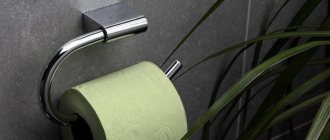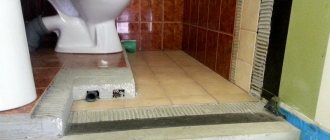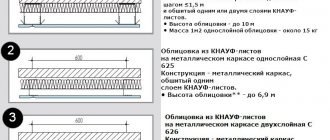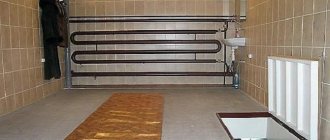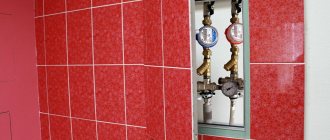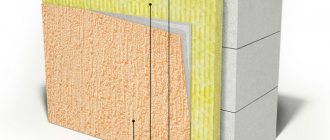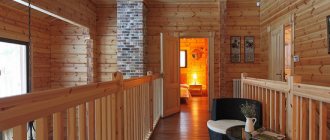Unfortunately, few flooring materials are suitable for furnishing a bathroom or toilet. This is due to increased humidity and temperature changes. The best option for these rooms is to use porcelain stoneware tiles. It has the following positive aspects of operation: reliability, durability, resistance to mechanical stress, moisture and elevated temperatures. Recently, laminate flooring has been used to furnish toilets. Let's consider whether it is worth using laminate to decorate the interior of a toilet, how to choose the right material, the positive and negative aspects.
DOMOSTROYPlumbing and construction
join the discussion
Share with your friends
Most often, the room of a separate bathroom or a bathroom combined with a toilet is decorated with tiles. However, if you want to create a more unusual and interesting interior, you can use laminate. It is perfect for both flooring and walls in the restroom. You will learn more about how to properly use material for finishing a toilet in our article.
Advantages and disadvantages
There is a wide selection of laminate flooring on the market today. However, only waterproof models are suitable for finishing a bathroom. Let's consider their advantages.
Of course, this material also has disadvantages.
Thus, it is important to take into account all the pros and cons of using this material and only then proceed to decorating the toilet room.
Available floor coverings for bathtubs are not very diverse, and most often the choice falls on porcelain stoneware-based tiles . However, some took a chance and began to install laminate flooring instead. Of course, its moisture resistance indicators are not the highest, but there are a number of factors that play into the advantage of choosing such a floor covering for a bath.
How and with what to fasten?
The adhesive laminate must be attached to flat surfaces. Liquid nails or construction silicone are used to hold it in place. The wrong side of the panel is covered with glue in the form of a zigzag, after laying the strip, coat the end with the same glue, and proceed to the next chain. If adhesive liquid appears at the boundaries of blocks and lines, it is immediately removed with a soft cloth made of natural fabric soaked in culinary acetic acid.
Laminate that is installed with glue cannot be fixed to the sheathing; it has too little contact strip with the support.
The tongue and groove type of laminate is equipped with a lock of the same name. This coating can be laid out without smearing the tongue with adhesives. Therefore, the borders of individual boards will not be stained with adhesive. If you don’t want to glue at all, you can nail the product to the surface in the manner of a regular lining. It is attached to a wood lattice using furniture nails or gluers (the second option is also suitable for an iron base).
For wall laying, you can also use click format laminate - this is an improved version of tongue and groove covering. The cut of the ridge is pear-shaped, as is the structure of the channels. The connecting structures push the ridge lobe of the lock into the niche, having first tilted the block. Then they twist the product towards the base and at the same time press lightly, due to which the lock closes. The click type of laminate is good for its high hardness.
Click coated gluers are not compatible. If you use them, you will not be able to latch the lock. But it is quite possible to glue the block onto a wooden sheathing yourself.
About laminate
Laminate is a floor covering that imitates parquet . The material used to make it is a pressed HDF board , which is subjected to high pressure and temperature. Next, a decorative layer with a polymer base is applied to it, which is protected by a wear-resistant film. Its main difference from other coatings is that it is not made from wood . Despite this, it is quite difficult to distinguish laminate from natural coating externally. The production of the first is so developed that the applied texture can imitate marble, wood, paintings, granite and can have all sorts of patterns.
Conclusion
If a person decides to install laminate flooring in the bathroom, he should be extremely careful about his choice . It must be different from other models and have special treatment for moisture resistance. This option is especially good for a separate bathroom. It is also worth paying attention to ensuring that the surface is rough, as this will prevent the risk of unwanted slips.
For small rooms, it is better to choose a cool and light color scheme; it will visually expand and enlarge the room. Warm tones do exactly the opposite. However, if the walls have a light shade, then a dark design is also suitable for the floor; against the backdrop of contrasting colors, the effect will visually expand the space.
One of the most difficult rooms to renovate in a home is the bathroom. After all, in a small room you need to fit a lot of necessary items. In addition, there is a problem with the use of materials. Because you need to take into account the increased humidity of the room. Therefore, they are wondering: is it possible to use laminate flooring in a toilet? And how he will behave in this room.
Rules for choosing materials
In order for the laminate to be not only practical, but also durable, for the presented room you need to choose a coating based on the following rules:
- The coating must be protected from moisture. It is best to use a varnished surface. A layer of varnish provides additional protection, creating an attractive interior. You also need to pay attention to waterproof slats. This will allow you not to change the decoration in this room for a long time;
- Attractive appearance. The shade and texture of the floor must correspond to the chosen interior style. Since the room is small, it is best to use light shades; they will visually make the toilet several times larger;
- Choose the right type of locks. This affects the quality of the product and ease of installation. Usually a special lock is used; for toilets, it is best to use wax-coated locks.
Laminate features
This coating has a poison of advantages:
Despite all its advantages, the material has one drawback - it is afraid of moisture. Therefore, it is not advisable to install such a coating in rooms with high humidity.
Damaged coating
Important! For use in toilets, panels with a moisture-proof bottom layer are chosen.
If water gets on the slats, they will swell and warp. And this can happen quickly. But the worst part is that even exposure to high humidity can cause damage to your floors.
Class, color and other factors
When choosing laminate for walls, you can relax a little. It is more difficult to choose for the floor, since the base is in any case exposed to much greater impact than the same walls. But, nevertheless, the class, color and type of coating must be taken into account when deciding to install it on the walls.
Laminate class table
Table. Tips for choosing laminate.
Way out
However, there is a way out of this situation. The fact is that moisture is not absorbed through the front part - it is protected by a special film. Vapors or droplets penetrate through the joints between the slats and are absorbed into them. After all, there is no such protection on the sides. The lower part of the panel is also susceptible to absorption, but they can be protected.
Bathroom
Therefore, if you plan to install this material in the bathroom, adhere to the following rules:
Source
Methods
You can attach the laminate to the walls either with glue and liquid nails (but you will need to thoroughly level the base and prime it), or using slatted lathing (but it will take up some of the space, so it is not recommended in small rooms). If you decide to nail the covering to the entire wall or to its upper part, work begins from the ceiling to the floor; Decoration of the lower half of the walls is carried out from the floor upward. To ensure that the planks are firmly fixed, check their correct installation using a building level. When there are locks in the panels, they should be glued like this: first coat the surface with glue, then connect them into a lock, and only then attach them to the wall.
If you think that glue alone is not enough, additional reinforcement of the structure with nails or staples is acceptable. The tongue and groove board is attached to the sheathing with clamps at the top and bottom.
Laminate in the toilet
Unfortunately, few flooring materials are suitable for furnishing a bathroom or toilet. This is due to increased humidity and temperature changes. The best option for these rooms is to use porcelain stoneware tiles. It has the following positive aspects of operation: reliability, durability, resistance to mechanical stress, moisture and elevated temperatures. Recently, laminate flooring has been used to furnish toilets. Let's consider whether it is worth using laminate to decorate the interior of a toilet, how to choose the right material, the positive and negative aspects.
Disadvantages of use
But, despite this, laminate is used in the toilet much less often than ceramic tiles, since the coating has the following disadvantages of use:
The use of wood and all its variations as decorative wall decoration is a sign of refined taste and respectability. But since the scope of use of wood and MDF is somewhat limited, an alternative has to be used. An excellent replacement is laminate.
This type of finish appeared on the market thanks to the development of innovative technologies, which made it possible to obtain a surface almost identical to real wood, which costs much less. Thus, renovation using laminate panels that look like wood has become accessible to every family.
Laminate finishing will be appropriate in any room, regardless of its stylistic decision. Some owners go even further and decorate the toilet walls with laminate. Let's try to figure out what is needed for this.
Parameters for selecting the type of laminate
Bathrooms and toilets are rooms with high humidity, so when choosing a laminate for wall finishing, you need to focus on the following parameters:
At the same time, you need to know that laminate on the wall in a toilet may not be the best solution due to a number of its disadvantages:
In this regard, we recommend that you think again before installing laminate flooring on the walls of the loggia, bathroom and kitchen. If the decision remains unchanged, then at least we advise you to choose the most expensive and high-quality laminate, which must be carefully looked after during operation and use various protective agents such as joint sealant.
Additional items
The choice of items to strengthen and hold the structure is extremely important. The most common seemingly ordinary clamps are available in a wide range, and if you purchase the wrong product, you will devalue all your work. The thicker the panel that needs to be held, the larger the diameter of the tongue should be . Compared to other types of mechanical fasteners, clamps have the advantage of having a low risk of panels splitting. They are great even in rooms with significant humidity. A bracket with a jagged protrusion is driven into the board and held in place with self-tapping screws; a bracket with a flat protrusion will help press the protruding part of the click lock against the wall or sheathing.
When choosing liquid nails, be sure to check their area of application. They are both universal and intended for interior work. Very dense laminate cannot be attached to walls , so there is no point in using liquid nails to hold heavy objects. Acrylic composition cannot be used at subzero temperatures.
Covering the end of the laminate on the wall is not so easy, but this task can be solved. According to experts, profiles in the shape of the letter P, which are made from a variety of materials, will help - there are aluminum, plastic, and even wood. As an option, you can purchase a flexible rubber threshold. All these blocks can be attached using the same liquid nails or glue-sealant. Sometimes they also offer edge tapes, but any method should not disturb the color harmony of the canvas.
A separate topic is guides for wall mounting of laminate; the step between them should not be more than 0.6 meters.
Methods for installing laminate flooring on a toilet wall
There are only two options: installation with glue and on a wooden sheathing. Wall mounting using liquid nails or glue is popular due to its simplicity and the ability to combine different color and texture solutions of panels. In this case, you will need to carefully prepare the base - it must be perfectly flat without any defects.
Attaching laminate flooring with glue to a wall with uneven surfaces can spoil the appearance of the finished coating, and during operation the panels may begin to peel off along with the putty. This fastening method is definitely not suitable for budget-conscious people, because you will have to spend a large sum on preparatory work alone.
Finishing a toilet with laminate using glue is very simple and you can do all the work yourself. You can glue any laminate with or without a locking joint.
Some manufacturers immediately produce laminate panels with a fastening system that will make it much faster to install the trim on the sheathing. In any case, to complete the work you will need:
Wall finishing options
To create a neat and beautiful environment, all sewer connections located in the toilet must be hidden. The simplest design for masking pipes is a box made of plastic or plasterboard. In a niche you can also hide a water heater, a narrow washing machine, or make a cabinet for household chemicals. The sheets are attached to the frame, and an inspection hatch is installed to access pipes and meters. After this, the box is lined with tiles or other materials. No less convenient access to communications and the boiler is provided by roller shutters or blinds to match the color of the wall decoration. For budget finishing of the toilet, materials left over after renovation are suitable. The tile goes well with paint or decorative plaster. Finishing the upper half of the wall with a light material and the lower half with a brighter or darker one will visually expand the room.
Ceramic tile
To decorate the walls in a small toilet, choose medium-sized tiles. To avoid narrowing the room, it should not be too dark. Laying in horizontal stripes with noticeable seams looks impressive and expands the space. Vertical stripes distance the ceiling. The walls are decorated with details of different sizes, borders, abstract decor, contrasting corners, accent rows. In a narrow toilet room next to a wall lined with plain tiles, a mosaic looks beautiful. Bright mosaic tiles are combined with light and snow-white surfaces. With the help of mosaics, accents are created on the entire wall, corners, borders, and built-in shelves.
In small rooms, the mosaic gradient should move from a dark bottom to a light top. Pixel mosaic (a combination of several shades in a chaotic order) gives the interior dynamism and brightness. To imitate brickwork in the toilet, boar tiles are used. It is advisable to use volumetric rectangles with a beveled end chamfer to cover an accent wall or lower part. The hog fits into the Scandinavian style, loft, minimalism. Ceramic tiles are impervious to moisture and steam, cleaning agents, and can be used for finishing combined toilets and showers. With the right choice of shades, tiles have no disadvantages.
Washable wallpaper
We sell a large selection of wallpapers of various textures, patterns, and shades that are suitable for any design style. Depending on the material and production technology, washable wallpaper is divided into several types.
Wallpaper types:
| Type | Peculiarities | |
| 1 | Flat Vinyl | Reproduces the surface of plaster, stone, textiles, sticks to well-prepared surfaces, is expensive |
| 2 | Foamed Vinyl | It has a pronounced relief, imitates tiles, mosaics, stone, and hides wall unevenness well |
| 3 | Acrylic canvases | Thin, with a subtle relief pattern, easy to stick, inexpensive |
| 4 | Glass wallpaper | Strengthens walls, withstands numerous stains, is resistant to scratches and mold fungi |
| 5 | Non-woven wallpaper | Hides minor defects, dark spots on the wall, sticks without preparatory work, is not scratch-resistant |
| 6 | Metal wallpaper | Aluminum-coated canvases look original and are suitable for decorating an accent wall in the toilet |
The advantages of wallpapering a toilet: quick finishing without dirt or difficult surface preparation.
Disadvantage: they become unusable due to unexpected leaks.
Panels
PVC panels will help to restore order and create a pleasant environment in the toilet at minimal cost. The sheets are quickly mounted on a wall or sheathing, masking pipes and meters. Light material is used to cover dilapidated surfaces. For a small toilet, purchase wall panels that are not too wide with a small pattern. The covering is not afraid of moisture, cleaning agents, or scratches. Vinyl siding does not rot, is not afraid of direct contact with water, and can be cleaned with a sponge.
Advantages of paneling:
- suitable for creating a box;
- easy to cut and saw;
- reliably imitate ceramic tiles and stone;
- 2-2.5 times cheaper than tiles.
Flaws:
- during frame installation, space is lost;
- They are afraid of blows and sharp objects.
Tree
Wooden wall decoration, echoing the plank floor, ennobles the space and is suitable for covering spacious toilets in private homes. The lining can be painted to match the plumbing fixtures, or combined with painting or plaster. Light-colored wooden trim around the perimeter visually expands the walls. Brown or dark gray slats laid on an accent wall in a parquet manner will add depth and highlight the whiteness of the toilet. White lining in combination with plastered surfaces or light gray wallpaper is appropriate in the Scandinavian style. The abundance of wood in a small toilet causes discomfort; lining is used only for combined finishing. For example, a back wall made of transverse slats in brown tones, combined with smooth plaster and laminate flooring, looks distinctive. In a country house, a separate bathroom can be completely covered with wood.
To finish a combined toilet, the wood is coated with varnish with water-repellent properties, and the varnishing is repeated after 5-6 years. Wooden walls will retain their original appearance for a long time in a bathroom with good built-in ventilation.
Dye
Painting the top of the wall white and the bottom in pastel shades will visually expand the boundaries of the toilet. To prevent the room from being dull, choose lilac, lemon, turquoise, and spring green tones. Finishing will be cheap, but the paint will highlight defects; you will have to work hard to prepare the surface well and eliminate uneven corners. The separate toilet is painted with water-based, acrylic compounds. In a shared bathroom, an additive is added to the paint to protect against mold. A tile apron is laid out near the sink and bathtub.
Benefits of painting walls:
- easy application and care;
- quick change of boring color;
- simple decoration of rooms with projections and complex configurations.
Flaws:
- the need to carefully repair dents and scratches;
- slight dirt is visible.
To prevent the walls from looking too simple, paint is combined with tiles, panels, and wooden slats.
Decorative plaster
Using various finishing techniques, you can make a coating for concrete, travertine, stone, sand surface, and give the desired shades with tinting solutions. There is no dampness in a separate toilet, and mold does not form, so ordinary plaster mixtures are suitable. When finishing a combined bathroom, to prevent the development of fungi, antiseptics are added to the decorative plaster or mixtures based on moisture-resistant fillers are chosen.
Types of decorative plaster for bathrooms
| The basis | Characteristics | |
| 1 | Silicate | The most durable plaster with high vapor permeability and moisture resistance |
| 2 | Acrylic | The polymers included in the resin make air exchange difficult. Plastic material is easily applied, stretched or compressed when walls shrink |
| 3 | Mineral | Due to the inclusions of large fractions of marble, it creates a pronounced relief. Disadvantage – low elasticity, not recommended for bathrooms in new buildings |
| 4 | Silicone | Elastic composition with good hydrophobic properties, does not attract dirt |
Summary
It is best to use laminated panels of a high wear resistance class for installation in the bathroom and toilet. Their price is quite high, but otherwise the cladding will quickly deteriorate when exposed to moisture.
You can get inspiration from interior photos posted online, or trust your own taste. There is material on the market to suit every taste and budget, so the field for imagination is truly wide.
You can create an interior in any style. You can try to complete all the work yourself if you read the short list of installation recommendations. Then you can save on the work of a specialist.
But if you have doubts about your skills and abilities, it is better to hire an experienced craftsman who will definitely do everything as it should and will not have to do repairs again in a couple of months.
Source
How to lay it?
Laminate flooring swells as it becomes wetter. And therefore, no matter what installation method you choose, be sure to leave a gap of 1.5-2 centimeters from the corner along the entire perimeter. Spacer wedges on the walls can help with this, but there is a much better solution. Completely flat boards or slats of the required thickness are placed below, which are wrapped in thin plastic film. And on the sides you can safely use wedges, where they will not be squeezed out by the weight of the sheathing.
Experts recommend that after completing the work, lay a plinth over the gaps to prevent debris and dirt from accumulating there.
Laying the canvases should begin from the far left corners, it is carried out as the clock progresses. Left-handers will be more comfortable working on the right against the clock. Installation of laminate flooring is allowed both vertically (from left to right) and horizontally, with the second method being preferable. Solid strips, contrary to imaginary evidence, are by no means simpler or cheaper. Joints running along the same line must be covered with plinths attached to mounting nails.
The technology involves drilling mounting holes directly through panel joints. And even in the case when the wall is lined with continuous strips along its length, you will have to install skirting boards every 170 centimeters or even more often . Continuous panels support each other only in one direction, and if there is no additional reinforcement, the cladding can fold.
No matter how well you try to install the covering, no matter how high-quality nails, gluers and glue you use, these holding elements may no longer perform their function. Excessive proximity will create increased mechanical stress.
It is best to lay the laminate using the comb method: cut exactly in the middle as many strips as would fit on half of the horizontal rows. When ten lines can be laid in height, five strips are required to cut. Installation proceeds alternately: a solid part, then cut, again a whole block. This solution will make the load on the fasteners as uniform as possible.
